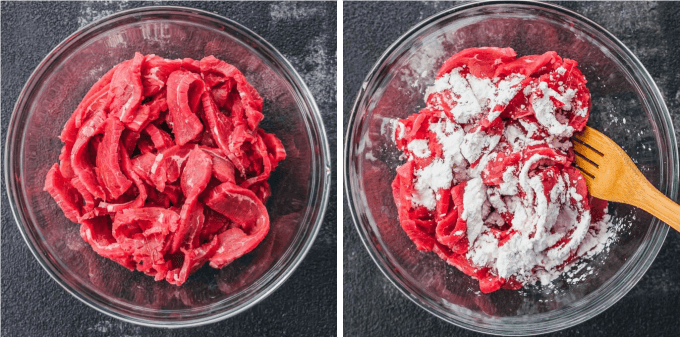Why Chinese Stir Fry Beef Is Soft
There's nothing worse than eating tough strips of stir fry beef. It makes you wonder how Chinese restaurants are able to make stir fry dishes with such supple and velvety beef strips.
Below I've collected my top tips for cooking restaurant-style beef strips that come out perfectly tender and juicy. Follow these steps to select and prepare your beef for optimal cooking that results in juicy meat.
1. Select An Appropriate Cut of Beef
Choose a cut of steak such as flank steak or better. The more premium the cut, the more tender the meat. I usually opt for flank steak because it strikes a good balance between budget friendliness and tenderness.
Some supermarkets will have pre-cut beef strips, often labeled as "beef for stir fry" or similar verbiage. These will also work well, but the downside is that they're usually sliced too thick (see below) and it'll be difficult to slice them thinner once cut.
2. Slice Against The Grain
Inspect the steak and look for long muscle fibers. Notice how they are aligned with the steak. You should slice perpendicular to those lines, so that you are cutting through the fibers.
By slicing through the fibers, you are slicing "against the grain," which results in less work for your teeth and makes the beef taste more tender.
3. Cut Thin Slices
Make thin cuts about 1/4 inch or thinner. Thin strips of beef are best because they won't take long to cook. The thinner the beef, the more tender it will taste and the less chewy it will be.
Thicker strips require longer cooking times, which usually means the outside is overcooked by the time the inside is cooked. It's easier to accidentally overcook a thicker strip of beef than a thinner one. An overcooked thick strip will also be tougher than an overcooked thin strip.

4. Toss With Corn Starch
After slicing the beef, toss it with corn starch before cooking — about 1 tablespoon of corn starch for 1 pound of beef. This is similar to (but less involved than) a common technique in Chinese restaurants called velveting, where they will marinate meats in corn starch and cooking wine or soy sauce for about 15 minutes. The corn starch helps keep the beef moist and tender while cooking.
It's very noticeable when cooking meat tossed with vs. without corn starch — the meat without corn starch will exude liquid as it cooks, whereas meat coated with corn starch will retain its liquid content, making it more tender.
5. Don't Overcook
Thinly sliced beef only needs to be briefly seared on a hot pan before it's browned and cooked through, about a few minutes. Once the beef is browned on all sides, it is done and can be removed from the pan.
Don't overcook the beef, or it will become tough.
Best Ways To Stir Fry Beef
You can stir fry beef with vegetables like broccoli florets, zucchini, carrots, bell peppers, and mushrooms. Typically, you will sear the beef first, transfer it to a plate, and separately cook the vegetables. You don't want to cook them simultaneously because vegetables release liquid as they cook, which prevents your meat from obtaining a nice sear.
Stir fry sauces can be a simple soy sauce blend, or mixed with a chili paste. You can add other aromatics such as minced garlic, freshly grated ginger, chili peppers, and sesame oil.
If you're looking to try your hand at making a tender beef stir fry, check out my recipes for Mongolian Beef or Crazy Good Beef And Broccoli. I also have a healthier, low carb version of Beef And Broccoli.
Source: https://www.savorytooth.com/tender-stir-fry-beef/
0 Response to "Why Chinese Stir Fry Beef Is Soft"
Post a Comment